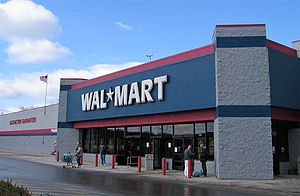Discount store
This article has multiple issues. Please help improve it or discuss these issues on the talk page. (Learn how and when to remove these messages)
|

A discount store is a retail store which sells products at prices that are lower than the typical market value. A "full-line discount store" or "mass merchandiser" may offer a wide assortment of goods with a focus on price rather than service, display, or wide choice - such as Aldi and Lidl; a "speciality", "single line", or "category killer" discount store may specialize in specific merchandise such as jewelry, electronic equipment, or electrical appliances, relying on bulk purchase and efficient distribution to keep down cost - such as Toys "R" Us and Staples.[1] Discount stores are not variety stores, which sell goods at a single price-point or multiples thereof (£1, $2, etc.). Discount stores differ from variety stores in that they sell many name-brand products, and because of the wide price range of the items offered. Following World War II, a number of retail establishments in the U.S. began to pursue a high-volume, low-profit-margin strategy designed to attract price-conscious consumers.[citation needed] This strategy has received renewed interest from retailers and customers alike stemming from the Great Recession that began in 2007 that forced buyers to revisit the approach to the products they wanted.[2]
Currently Aldi, the largest retailer in the world (Planet Retail Ranking; June 2014), operates more than 10,121 discount stores worldwide.[3]
History


Australia
Australia has four main discount stores including Aldi, Big W, Kmart, and Target, plus in the Sydney region only, Victoria's Basement.
New Zealand
New Zealand's main discount stores includes The Warehouse.
Japan
Japan has numerous discount stores, including Costco.
Iran
Italy
Italy has numerous discount stores. The most important chain is Eurospin[citation needed], while others include Tuodì, MD Discount, Todis, DPIU' and Discount Dial. Here are also Lidl and Penny Market.
Germany
The most important discount stores in Germany are Aldi, Lidl, Netto Marken-Discount and Penny.
Poland
Discount stores cover about 20% of food sales in Poland. Main retailers:
Portugal
- Aldi
- Lidl
- Minipreço
- Plus sold to Jerónimo Martins
- Netto converted into Intermarché
Turkey
- Şok Market
- BiM
- A101
United Kingdom
Competition in the global discount store industry has intensified as the various players try to undercut their rivals to attract new customers and retain existing customers with low priced goods.[4]
See also - List of discount stores in the United Kingdom
United States
During the period from the 1950s to the late 1980s, discount stores were more popular than the average supermarket or department store in the United States. There were hundreds of discount stores in operation, with their most successful period occurring during the mid-1960s in the U.S. with discount store chains such as Kmart, Ames, Two Guys, E. J. Korvette, Mammoth Mart, Fisher's Big Wheel, Zayre, Bradlees, Caldor, Jamesway, Howard Brothers Discount Stores, Kuhn's-Big K (sold to Walmart in 1981), TG&Y and Woolco (closed in 1983, part sold to Wal-Mart) among others.[5]
Walmart, Kmart, and Target all opened their first locations in 1962. Other retail companies branched out into the discount store business around that time as adjuncts to their older store concepts. As examples, Woolworth opened a Woolco chain (also in 1962); Montgomery Ward opened Jefferson Ward; Chicago-based Jewel launched Turn Style; and Central Indiana-based L. S. Ayres created Ayr-Way. J. C. Penney opened discount stores called Treasure Island or The Treasury, and Atlanta-based Rich's owned discount stores called Richway. During the late 1970s and the 1980s, these chains typically were either shut down or sold to a larger competitor. Kmart and Target themselves are examples of adjuncts, although their growth prompted their respective parent companies to abandon their older concepts (the S. S. Kresge five and dime store disappeared, while the Dayton-Hudson Corporation eventually divested itself of its department store holdings and renamed itself Target Corporation).[citation needed]
In the United States, discount stores had 42% of overall retail market share in 1987; in 2010, they had 87%.[6]
Many of the major discounters now operate "supercenters", which add a full-service grocery store to the traditional format. The Meijer chain in the Midwest consists entirely of supercenters, while Wal-Mart and Target have focused on the format as of the 1990s as a key to their continued growth. Although discount stores and department stores have different retailing goals and different markets, a recent development in retailing is the "discount department store", such as Sears Essentials, which is a combination of the Kmart and Sears formats, following the companies' merger as Sears Holdings Corporation.
Discount stores in the USA have included
See also
References
- ^ Charles Lamb (1 Jan 2011). Essentials of Marketing. Cengage Learning. p. 465.
- ^ Times, LA. "The New Fashion. Second Hand Designer Clothing at Discounted Pricing".
{{cite web}}:|access-date=requires|url=(help); Missing or empty|url=(help) - ^ http://www.handelsdaten.de/themen/387/aldi/
- ^ "Find a list of England's best online outlet stores:Published By Dealslands".
- ^ Arkansas, Encyclopedia of. "Wal-Mart Stores, Inc". Encyclopedia of Arkansas. The Central Arkansas Library System. Retrieved 8 February 2013.
- '^ "America's top stores." Consumer Reports, June 2010, p. 17.
Further reading
- Nelson, Walter Henry, The Great Discount Delusion, New York: D. McKay, 1965.
